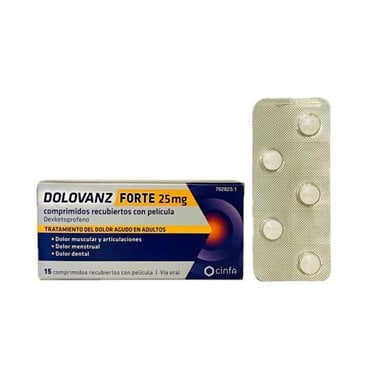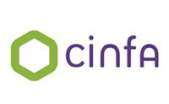Dolovanz Forte 25 Mg 15 Coated Tablets
Dolovanz Forte 25 Mg is an analgesic belonging to the group of medicines called non-steroidal anti-inflammatory drugs (NSAIDs). It is used for the short-term symptomatic treatment of acute pain of mild or moderate intensity, such as muscle or joint pain (such as back pain, sprains, and acute trauma), menstrual pain, or dental pain in adults. .
Dolovanz Forte 25 Mg is an analgesic belonging to the group of medicines called non-steroidal anti-inflammatory drugs (NSAIDs). It is used for the short-term symptomatic treatment of acute pain of mild or moderate intensity, such as muscle or joint pain (such as back pain, sprains, and acute trauma), menstrual pain, or dental pain in adults. .
Dolovanz Forte 25 Mg 15 Coated Tablets
dexketoprofen
ACTION AND MECHANISM
Dolovanz Forte acts as an analgesic, anti-inflammatory and antipyretic, inhibiting the synthesis of prostaglandins through cyclooxygenase. Dexketoprofen trometamol, derived from propionic acid, decreases the synthesis of prostaglandins, also affecting other mediators of inflammation such as kinins, providing an additional indirect action.
PHARMACOKINETICS
Absorption: Rapid gastrointestinal absorption with maximum plasma concentration in 0.5-0.75 hours after oral administration. Oral absorption is good. After intramuscular administration, maximum concentrations are reached within 20 minutes. Bioavailability is dose proportional for intramuscular and intravenous administrations.
Distribution: High binding to plasma proteins (99%), with an average volume of distribution of 0.25 l/Kg. Approximate distribution half-life of 0.35 hours.
Metabolism: Mainly by glucuronoconjugation.
Elimination: It is excreted through the kidneys (80%) in the form of metabolites conjugated with glucuronic acid. No conversion to the R-(-) enantiomer occurs in humans. Elimination half-life 1-2.7 hours.
Pharmacokinetics in special situations:
- Elderly: Higher exposure (up to 55%) and prolonged elimination half-life (up to 48%).
INDICATIONS
Treatment of mild to moderate pain such as musculoskeletal pain, dysmenorrhea and toothache. In parenteral forms, it is used for the treatment of moderate to severe acute pain when oral administration is not appropriate, such as in postoperative pain, severe renal colic, and low back pain.
POSOLOGY
Orally:
- Adults: 12.5 mg every 4-6 hours or 25 mg every 8 hours, not to exceed 75 mg/day.
- Elderly: Start with 50 mg daily, increasing to the adult dose if well tolerated.
Renal insufficiency:
- CrCl 50–80 ml/min: initial dose should not exceed 50 mg/day.
- ClCr <50 ml/min: Use not recommended.
Liver failure:
- Mild to moderate: initial dose should not exceed 50 mg/day, with careful monitoring.
- Severe (Child-Pugh score 10-15): Not recommended.
RULES FOR CORRECT ADMINISTRATION
Administer with food to avoid gastric irritation. In case of acute pain, it can be administered 30 minutes before meals. Avoid long-term treatments.
- Sachets (powder for oral solution): Dissolve the contents in a glass of water and take immediately.
- Sachets (oral solution): Press the sachet several times before opening. Take directly or diluted in water immediately.
ADVICE TO THE PATIENT
- Inform your doctor if you develop skin rashes, gastroduodenal ulcer symptoms, visual disturbances, weight gain, edema, or prolonged headache.
- Notify the doctor of any asthmatic reaction while using the medication.
CONTRAINDICATIONS
- Hypersensitivity to dexketoprofen or other NSAIDs.
- Patients with a history of hypersensitivity to acetylsalicylic acid.
- Digestive bleeding, active peptic ulcer, cerebral hemorrhage.
- Moderate to severe renal failure (CrCl < 50 ml/min).
- Severe liver failure (Child-Pugh score 10-15).
- Third trimester of pregnancy or breastfeeding.
PRECAUTIONS
- Renal failure: Risk of accumulation and possible acute renal failure. Monitor kidney function in high-risk patients.
- Liver failure: Risk of accumulation and liver toxicity. Monitor liver function in patients with liver diseases.
- Gastrointestinal toxicity: Increased risk of gastrointestinal ulcers and bleeding, especially in patients with a history of ulcer or in prolonged treatments. Administer with food and consider antiulcer drugs in at-risk patients.
- Cardiovascular diseases: Risk of fluid retention, edema, hypertension and thrombotic events. Monitor blood pressure and evaluate benefit/risk in patients with cardiovascular diseases.
- Skin reactions: Risk of serious reactions such as exfoliative dermatitis and Stevens-Johnson syndrome. Suspend treatment in case of hypersensitivity symptoms.
- Hypersensitivity reactions: Risk of anaphylaxis in patients with allergy to NSAIDs or salicylates. Use with caution in asthmatic patients.
- Coagulation disorders: Antiplatelet activity. Caution in patients with alterations in hemostasis or undergoing treatment with anticoagulants.
- Aseptic meningitis: Risk in patients with collagenosis.
- Ophthalmological symptoms: Risk of serious ocular reactions. Carry out periodic ophthalmological check-ups.
- Female infertility: May decrease fertility. Not recommended for women who wish to become pregnant.
PRECAUTIONS RELATING TO EXCIPIENTS
- Sucrose: Contraindicated in patients with hereditary fructose intolerance.
- Ethanol: Risk in patients with chronic alcoholism, pregnant women, infants, children and patients with liver disease or epilepsy.
- Benzyl alcohol: Do not administer to premature children or newborns.
- Sucrose in oral forms: It can harm teeth.
SPECIAL WARNINGS
- Gastrointestinal risk: Greater risk in the elderly and prolonged treatments. Monitor for signs of ulceration or bleeding.
- Cardiovascular risk: Increased risk of cardiovascular events. Monitor for signs of hydrosaline retention.
- Masking of infections: It can mask symptoms of infections. Monitor for infection and consult a doctor if symptoms persist or worsen.
INTERACTIONS
- NSAID: Avoid the simultaneous use of more than one NSAID.
- Alcohol: Enhances toxicity.
- Aliskiren: Possible reduction of antihypertensive effect.
- Alendronic acid, bisphosphonates: Increased risk of esophagitis and gastric ulcer.
- Quinolonic antibacterials: Risk of seizures.
- Oral anticoagulants, heparin: Increased risk of bleeding.
- SSRI antidepressants: Increased risk of bleeding.
- Antidiabetics: Possible hypoglycemic or hyperglycemic effect.
- Antidiabetic sulfonylureas: Increased hypoglycemic effects.
- Antihypertensives: Reduction of the antihypertensive effect.
- Ciclosporin: Increased nephrotoxicity.
- Antiplatelet agents: Increased risk of bleeding.
- Corticosteroids: Increase in gastric discomfort.
- Digitalis: Increase in plasma concentrations.
- Diuretics: Reduction of the natriuretic and diuretic effect.
- Potassium-sparing diuretics: Increased risk of hyperkalemia.
- Glitazones: Potentiation of edema.
- Hydralazine: Decrease of the hypotensive effect.
- Iloprost: Increased risk of bleeding.
- Lithium: Increased toxicity of lithium.
- Methotexate: Increase in plasma levels and risk of toxicity.
- Paracetamol: Increased risk of adverse kidney effects.
- Zidovudine: Increased hematological toxicity.
PREGNANCY
- Safety in animals: Cardiovascular malformations.
- Safety in humans: Risk of oligohydramnios and constriction of the ductus arteriosus from week 20 of gestation. Do not administer during the first and second trimesters unless strictly necessary. Contraindicated in the third trimester.
- Effects on fertility: May alter female fertility.
LACTATION
- Safety in humans: It is unknown if it is excreted in breast milk. Contraindicated.
CHILDREN
Safety and efficacy have not been established in this age group. Use not recommended.
ADVANCED AGE
Start treatment with the lowest dose. Higher incidence of gastrointestinal adverse reactions and renal, hepatic or cardiovascular alterations. Caution in patients over 65 years of age.
EFFECTS ON DRIVING
May cause dizziness or drowsiness. Avoid operating dangerous machinery until confirming that the treatment does not adversely affect you.
ADVERSE REACTIONS
- Alterations of the blood and lymphatic system: Anemia, neutropenia, thrombocytopenia.
- Metabolism and nutrition alterations: Hyperglycemia, hypoglycemia, hypertriglyceridemia.
- Nervous system alterations: Headache, dizziness, insomnia, drowsiness, paresthesia.
- Eye disorders: Blurred vision.
- Ear and labyrinth disorders: Tinnitus.
- Cardiac disorders: Extrasystole, tachycardia.
- Vascular alterations: Hypotension, hot flashes, arterial hypertension, malleolar edema, superficial thrombophlebitis.
- Respiratory disorders: Bradypnea, bronchial spasm, dyspnea.
- Gastrointestinal disorders: Nausea, vomiting, abdominal pain, dyspepsia, diarrhea, constipation, hematemesis, dry mouth, gastric ulcer, digestive bleeding, anorexia, pancreatitis.
- Hepatobiliary alterations: Increased transaminases, jaundice, hepatitis.
- Alterations of the skin and subcutaneous tissue: Dermatitis, pruritus, exanthematous eruptions, hyperhidrosis, urticaria, acne, severe mucocutaneous reactions.
- Musculoskeletal disorders: Muscle rigidity, joint stiffness, muscle cramps.
- Renal and urinary disorders: Increased urea nitrogen and serum creatinine, acute renal failure, interstitial nephritis, glomerulonephritis, renal medullary necrosis, nephrotic syndrome, proteinuria, hyperkalemia, hyponatremia, polyuria, edema.
- Alterations of the reproductive system: Menstrual cycle disorders, prostate alterations.
- General alterations: Pain at the injection site, reactions at the injection site, heat stroke, asthenia, pain, chills, low back pain, syncope, anaphylaxis, edema.
ADVERSE REACTIONS RELATING TO EXCIPIENTS
- Methyl parahydroxybenzoate: May cause allergy to parabens.
OVERDOSE
- Symptoms: Gastrointestinal and neurological alterations.
- Treatment: Stomach emptying, administration of adsorbent charcoal, monitoring and maintenance of vital signs, symptomatic treatment of gastrointestinal irritation, hypotension, respiratory depression and seizures. Dexketoprofen trometamol is dialyzable.



